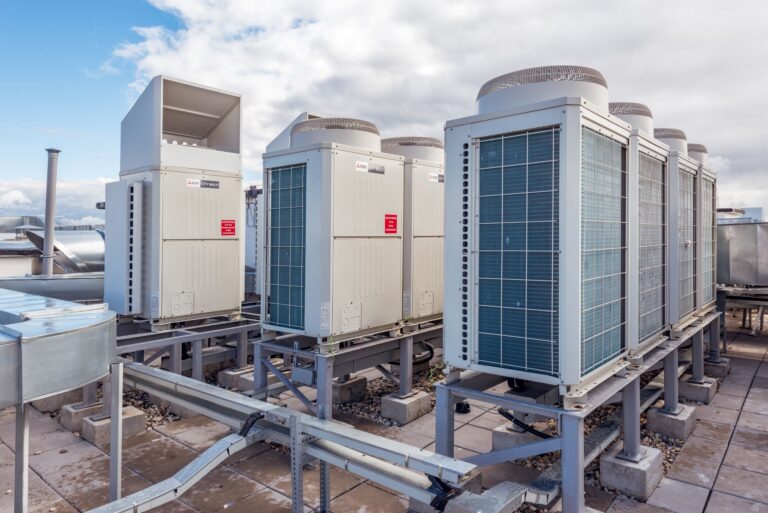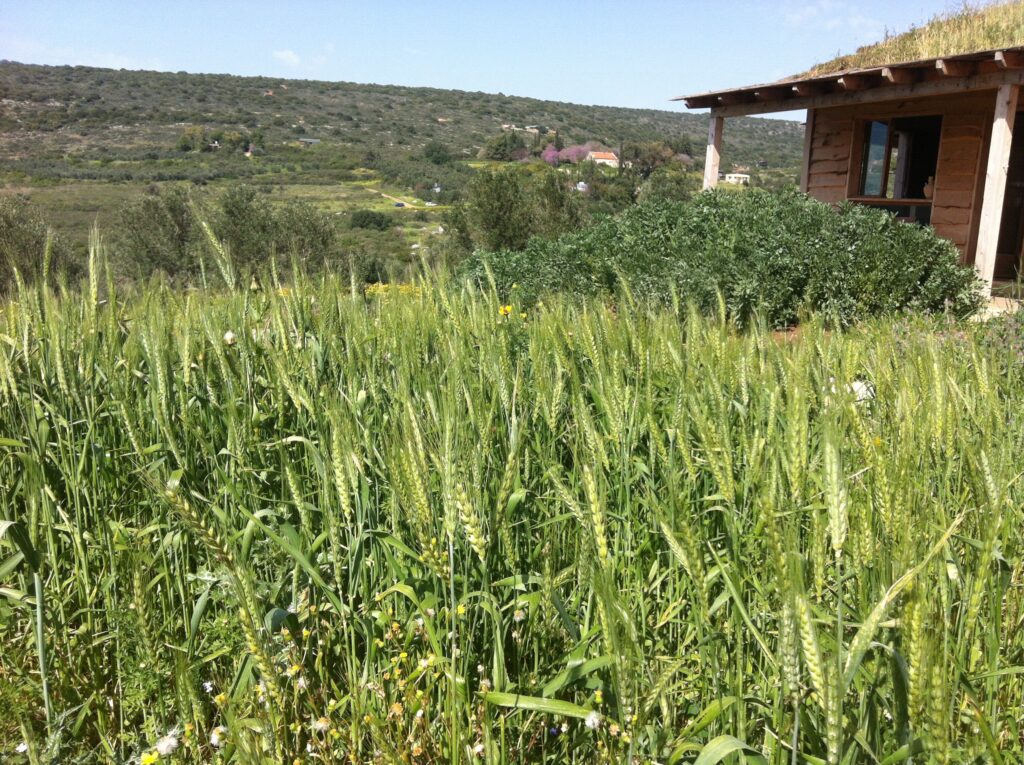Airconditioningsystemsforuseinbuildingsaredivided into twomaintypes:
unitary systems and central systems. To the first type belong window air conditioners, split air conditioners and mini-central ones. These are standard systems that constitute the lion’s share of installations in residential buildings and quite a few also in public, commercial and industrial buildings. Their cooling output usually ranges from 2-15 kW and can be installed in existing buildings without the need for advance planning. Over the past 20 years, there has been a continuous improvement in the performance of unitary systems: the coefficient of performance (COP) has more than doubled (an average array of 1.6 to 3.3 today); The noise level was greatly reduced; the design was improved and electronic remote-control signs were introduced; Recently, a load control system based on changing the speed of rotation of the compressor was introduced, enabling continuous control instead of on-off control that was accepted for many years – an issue of great significance for improving seasonal COP and saving electricity.
Central systems are installed in large, public and commercial buildings, and require advance planning, usually as part of the building’s design. Their main advantage is the distancing of the mechanical parts from the air-conditioned space, and the possibility of separate control of temperature, humidity and fresh air, which allows for higher quality air conditioning than that of unit systems. Their cooling output ranges from 100 tons of refrigeration to several thousand tons of refrigeration. Central systems are characterized in several ways: according to the method of transferring the cold from the engine room to the air-conditioned space – using cold air (air systems) or cold water (water systems); According to the method of removing heat from the condenser to the environment – cooling by air or cooling by water; And according to control methods that this is not the place to elaborate. The issue of air cooling versus water cooling comes up from time to time in the environmental context: systems equipped with a water-cooling tower allow a lower condensing temperature than air-cooled systems, and therefore allow for higher COP and power savings; On the other hand, they consume water and water treatment, and also produce brines that create environmental stress. As a result, the Director General of the Ministry of Environmental Protection issued a circular opposing the use of air conditioning systems based on water cooling towers.
The cooling element in any central air conditioning system is the chiller, which is the heart of the system, and usually operates in a vapor compression cycle by a compressor known by its trade name – Freon. As explained below, the use of refrigerants containing chlorine and fluorine compounds has an impact on two global phenomena – warming and ozone degradation, and there is currently a global effort to reduce the use of these refrigerants.
In small and medium-sized central systems, the use of piston compressors or screw compressors is common, while in large systems the use of centrifugal compressors is common.
The measure of the efficiency of an air conditioning system is the Coefficient of Performance (COP). This size, also called the “power digit”, defines the ratio of cooling output to power consumed. A distinction should be made between a nominal performance coefficient (COP) and a seasonal COP coefficient. Currently accepted values for a nominal performance coefficient, according to the manufacturer’s data, in unit air conditioning systems (almost all of which operate in a vapor compression cycle) are 3.2-3.3. The same values for central systems operating in a vapor compression cycle reach 5.5-4 with air cooling, and up to 7 with water cooling. In practice, the achieved performance is lower. Performance coefficients for air condensation coolers are on the order of only 2.2 to 3 at full load. IPLV (Integrated Part Load value) for above is around 4 to 5. Performance coefficients for coolers with water condensation are on the order of 4.5 to 5 at full load for screw units, 5.5 to 6 for centrifugal units. IPLV values for the above types of compressors are around 6-7 for the different units. At partial outputs, the performance coefficients increase, because the compressors that work in front of a large evaporator and high flow rate, and then in screw coolers the performance coefficient can increase by around 10-20%. All this – under nominal working conditions accepted by ARI (American Refrigeration Institute) or ASHRAE (American Society of Heating, Refrigeration and Air Conditioning Engineers), which are 12 °C return water supplied 7 °C, ambient temperature of 35 °C for units with air condensing, and input/output condenser water 35/30 °C for units with water condenser. It should be emphasized that for units with water condensation for which COP values are high, additional energy is consumed in the cooling tower and condenser water pumps. These are not reflected in the performance coefficient.
TheminimumCOPvaluesrequiredaredeterminedaccordingtothestandardsof the MinistryofNationalInfrastructuresand the Standards Institute, buttheyarerelevantonly for unitair conditioners.Thevaluesdefinedin the Israelistandardby the StandardsInstitutionofIsraelaremeasuredundercontrolledandstandardconditions.However,performanceinthefieldvariesdependingonthegeographicallocationofthemergedsite(coastalplain,lowlands,mountain,etc.),theinstallationenvironmentof the equipmentandthecharacteristicsof the operation.
The COP values of equipment imported from the United States are defined according to the requirements of institutions dealing with energy standardization. Values are set for both unit air conditioners and central installations.
Electricity consumption (according to IEC data, excluding self-production use) has consistently increased beyond the natural population growth rate. A major factor in this is the increase in cooling and air conditioning consumption.
Peak electricity demand shifted from winter to summer, caused by the use of air conditioning, mainly in the industrial and business sectors. During peak hours (midday hours during the summer months) the output for air conditioning reaches about 40% of the peak total demand.
Recommendations:
The forum’s recommendations include a wide range of issues that can be influenced and through which two goals can be achieved: saving energy consumption and shifting loads from peak hours. Considering this, the Forum recommends a range of integrated actions, with the agreement that the more comprehensive the implementation, the more significant the effectiveness achieved:
- Education for savings. Education for the intelligent use and proper maintenance of air conditioning systems crosses organizations and crosses audiences. Actions to educate the user public cost relatively little and may bring significant results in a short time. The issue of savings must be instilled into the consciousness of the public and at the same time create an organizational culture of savings among institutional entities. Alongside the need for awareness of the distancing and reduction of heat-emitting sources in air-conditioned spaces, there is a need for education towards the temperature of the air conditioner and turning it off when it is not needed.
- Standards. Preparation of detailed and clear standards for economical use of air conditioning systems and their enforcement. An entrepreneur who cannot or does not want to comply with the standard, will not receive a license to build. Periodic inspection of existing air conditioning systems will be required, as is done for elevators, lifting facilities, etc., and a system that does not meet the standard will cease operation until repaired. The rationale for such “draconian” demands energy saving is in the national interest. “Energy quotas” must be issued: an organization that exceeds the quota completely cuts off its electricity supply or pays a large fine. An organization that manages to consume less than specified for it receives a premium – see recommendation 3 below.
- Economic encouragement and incentives. At the same time as enforcing the standards, encouragement will be given to those who install and operate cost-effective systems beyond the requirements of the standard. Providing state guarantees for projects, accelerated depreciation on efficient systems, reducing or eliminating purchase tax on these systems, and ensuring that the budgets allocated to these projects are accessible and simple in terms of the required bureaucratic forms and approvals.
- Systems in government facilities. The government should be the first to demand and introduce efficiency criteria for air conditioning systems in its tenders. Government institutions will have an energy supervisor as is currently required in HMO hospitals, but not in government hospitals.
- Personnel training. Installers, operators and inspectors should be trained, and their certification and periodic training should be required in order to retain professional and up-to-date personnel who will perform installations, operation and maintenance according to metrics defined by the Ministry of National Infrastructures.
- Organization of public bodies. Professional bodies such as the Association of Refrigeration and Air Conditioning Engineers, the Manufacturers Association, the Local Government, the Association of Engineers, the Contractors Association, can be harnessed to create awareness and savings activities from below.
- Demand shift. One of the solutions for shifting demand, in the medium and long term, is to encourage the establishment of cold storage systems using ice or cold water.
- Saving on buildings.
8.1. In the immediate term, it can be implemented by shading the buildings, installing new thermometers and temperature controls, and installing automatons to turn off the air conditioning systems.
8.2. Implementation of Standard 1045 and its enforcement by the Ministry of the Interior through the Planning and Building Committees.
8.3. Promoting energy-conserving construction beyond the requirements of the standard. As already mentioned, a separate forum will deal with priorities and priorities in this area.
- Air cooling vs. water cooling
Establishing an inter-ministerial team of experts that will analyze, while examining all the considerations, the advantages and disadvantages of water-cooled and air-cooled systems, and ultimately present the systems whose installation the state should encourage.












